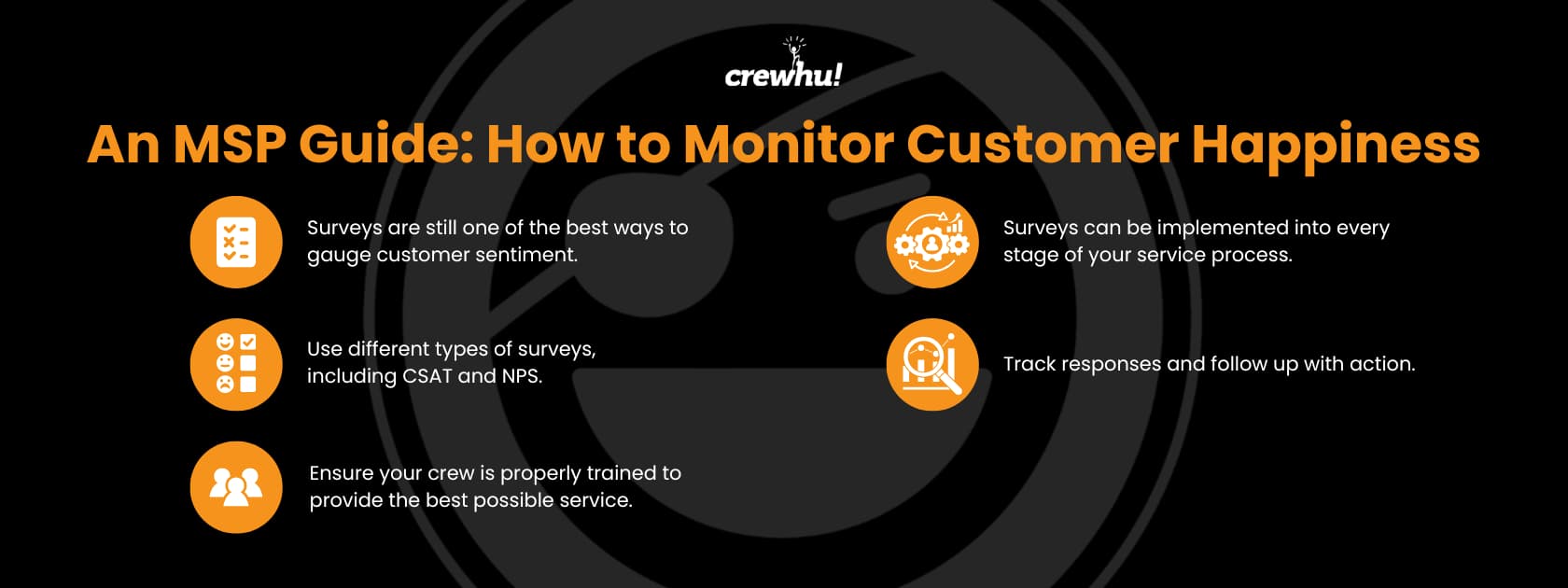An MSP Guide: How to Monitor Customer Happiness

A loyal customer base requires happy customers. Here’s how you can earn their smiles.

You know that unhappy customers will most likely end up as former customers if their complaints go unaddressed. Most businesses recognize that customer happiness is key to their success, but they often have difficulty measuring customer satisfaction.
If you don’t know the problem, how can you solve it? Let’s explore some ways to make sure you’re monitoring customer happiness.
Start with surveys
Despite some business owners' hesitation, surveys are still one of the most effective tools for gauging customer feedback. They not only reveal areas for improvement, but also help identify at-risk clients–which means they provide the insights needed to reduce customer churn..
The key to maximizing the value of surveys is designing them for maximum response rates. After all, they’re only useful if your customers participate.
Let’s take a look at some important factors to consider when creating a survey for your customers:
- Make it as easy as possible: The best surveys respect your customers' time and allow them to select their answers from several choices.
- Keep it short: The shorter the survey, the higher your chances of getting a response.
- Ask pointed questions: Make your questions as direct and focused as possible; generalities are useless because they don’t allow you to identify key issues.
- Ask about renewal intention: Whether your customer intends to renew their contract with you is a good way to gauge how satisfied and happy they are with your service.
- Implement surveys into your service process: Tell customers up front that you’ll be sending them a survey because you value their input and will use it to improve your service.
- Survey regularly: Whether you do it every quarter or on another schedule, getting customer feedback regularly empowers you to address issues before they cause churn.
- Don’t overdo it: Avoid creating surveys that your customers dread. Use them only at specified times, such as when a customer closes a ticket.
Types of surveys
Implement different types of surveys to reach customers at various touchpoints in the buying or service process. Here are a few that provide great impact:
- A CSAT Survey - This generally involves two parts. The first asks respondents to rate their happiness with a particular experience. The second asks about the reason for the score. You can tailor both questions to fit your need
- NPS Survey - This measures customer loyalty by asking if customers would recommend you to someone else. It may come in two parts, the first asking to rate the experience, and the second regarding the reason for the rating.
- Custom Survey Data - Crewhu can help you develop real-time, custom surveys and methods that track activity and dynamically improve your customer service.
Track the responses
Surveys only matter if you track and respond to the feedback you receive. Why bother if you’re not willing to change? Implement a system for tracking all survey responses. All feedback is helpful and should be used to gauge changes in your service.
Respond immediately (and personally) to any issues that arise from surveys. An email sometimes isn’t enough. Take the time to call the client directly and discuss their issues, or set up an appointment to meet in person, if possible.
Follow up with an action plan
It's important to follow up after requesting customer feedback. Some customers will respond immediately, others will take longer, and some may not respond at all. You don’t want to hassle your customers, but following up is key to increasing response rates and understanding which customers are satisfied–and which are not.
- First follow up: Send a friendly reminder email one week after the survey was sent.
- Second follow up: Send a second friendly reminder two weeks after the survey was sent.
Each follow-up email should include a link to the survey and a quick note about how much their opinion matters to you. Customers who don’t respond to either follow-up are likely too busy or not interested in participating.
Your final follow-up on these folks should occur a few weeks after the second reminder, and you should give them the option to call you directly with any criticism or issues.
Put your crew to work
Your team is on the front lines of customer engagement, so it makes sense to get them involved in ensuring that customer service protocols are met and exceeded.
The first step is to ensure that all your team members know the level of customer service that is expected. You must also train each crew member on how to interact and serve customers.
Looking for a great way to spur action, measure performance, and celebrate success? Recognize and reward your crew with incentive programs and competitions. This can foster a culture of winning to ensure every customer receives the best possible experience every time they interact with your company.
To learn more about how surveys can up your customer service game, book a demo with Crewhu today.
Topics: Blog






